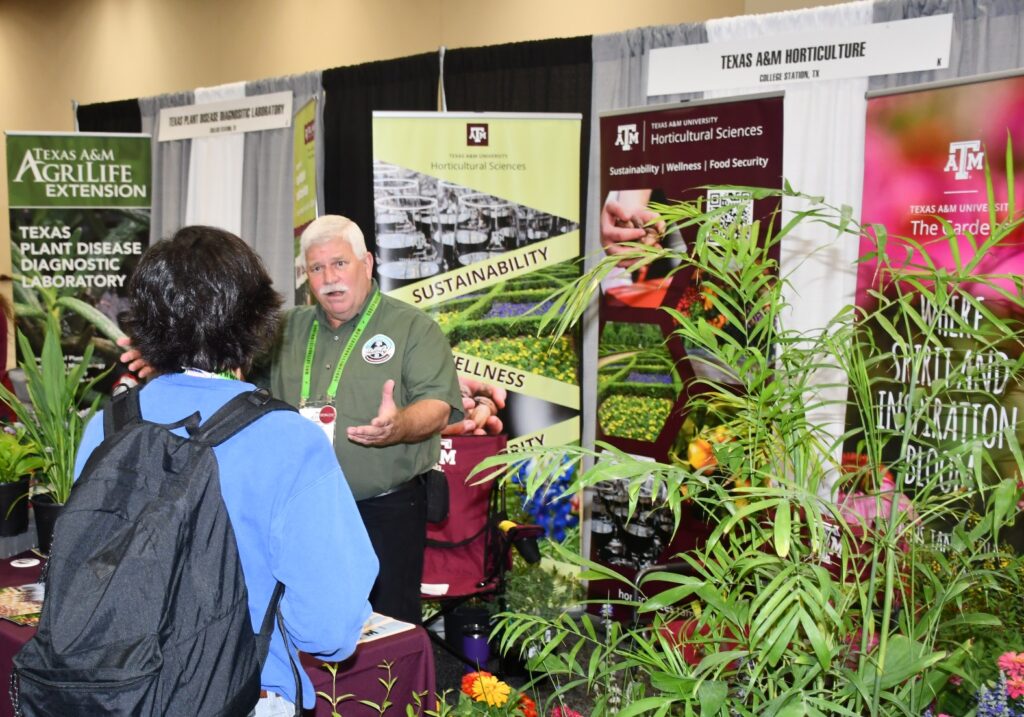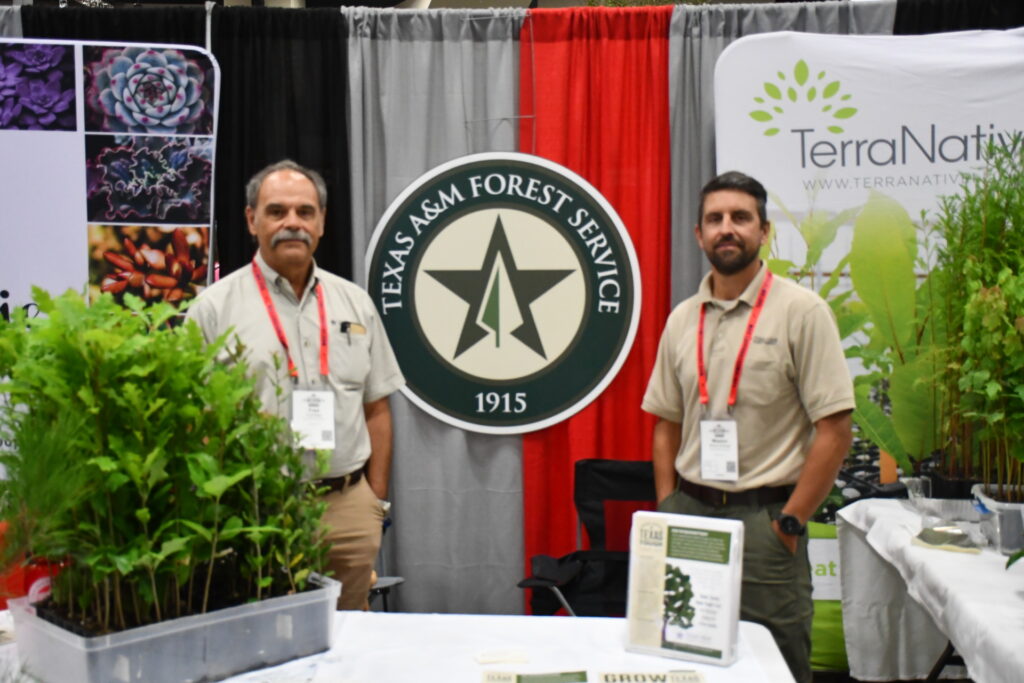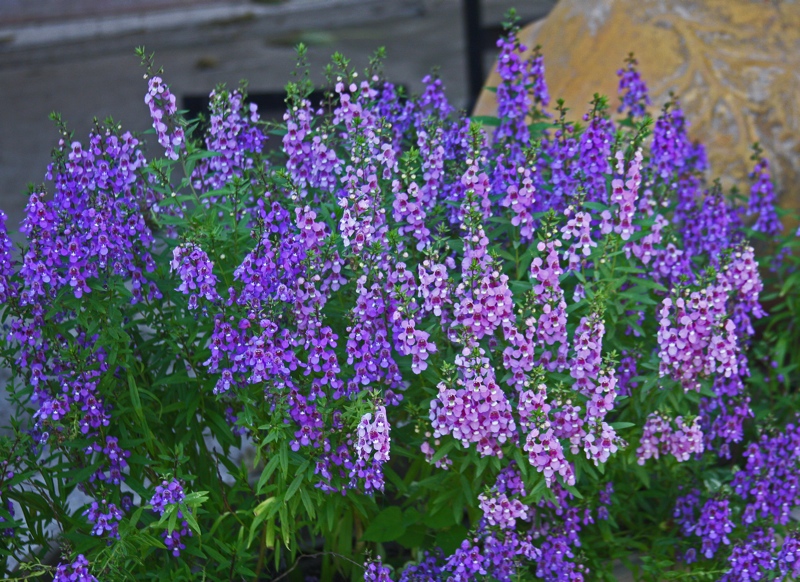Green industry focused on drought impacts at nursery and landscaping expo
Texas A&M AgriLife experts provide information, advice, services to green industry stakeholders
Drought — and its impact on turf grass, plants and trees — was a hot topic during the recent Texas Nursery and Landscaping Association exposition in San Antonio.

Fortunately, experts from Texas A&M AgriLife were available to answer questions and provide information and guidance on this and other topics to many of the expo’s 4,900 attendees. Those attendees ranged from gardening enthusiasts to professional landscapers, commercial nursery owners and other green industry stakeholders.
Representatives from across Texas A&M AgriLife, including from the Texas AgriLife Extension Service and Texas A&M Forest Service, as well as experts from across Texas A&M’s College of Agriculture and Life Sciences Department of Horticultural Sciences and Department of Plant Pathology and Microbiology, provided a variety of horticulture-related and other educational materials at the expo.
Additionally, Texas A&M AgriLife experts from the Texas Plant Disease Diagnostic Lab and Texas Superstar program were available to answer attendee questions.
Building awareness
“This expo is where many people in the green industry come for informational and educational opportunities and to share their challenges,” said Amit Dhingra, Ph.D., head of the Department of Horticultural Sciences, Bryan-College Station. “And this is where Texas A&M AgriLife has a chance to showcase what information, advice and services we provide to support our nursery and landscaping industry.”

Dhingra said the expo also provides the opportunity to build awareness of Texas A&M AgriLife efforts, as well as reach out to young people interested in gaining an education in horticulture for future professional opportunities in the green industry and reconnect with former students now employed in that industry.
“We’re taking this opportunity to talk about possible internship opportunities for students and networking to connect students and industry,” Dhingra said. “We want to make people aware of the many well-paid opportunities in horticulture, such as orchard manager, nursery manager, landscaper, floral designer, research scientist, viticulturist, winemaker and other career choices.”
Tammy Neel, a program coordinator in the Department of Horticultural Sciences, said the expo also provides an opportunity to connect students interested in a horticulture-related career with those already involved in the green industry.
“This gives us a chance to ask those in an already established green industry business if they are looking for interns or full-time employees so we can see if there may be job opportunities for students who are still in our undergraduate program or have recently graduated,” she said.
Neel said 10 Texas A&M Horticulture Club members assisted with booth set up and take down at the expo. Plants donated to the club from the expo will be sold at the annual Fall Plant Sale on Oct. 20-21. Donations will help pay for club member travel.
“The Horticulture Club is a social organization dedicated to bringing Texas A&M students together who share a passion for plants and making a mark on the horticultural community,” Neel said. “Through the club, there are opportunities to learn new information and techniques from guest speakers, professors and each other.”
Each year, the club represents Texas A&M at the Association of Collegiate Branch competitions of the American Society for Horticulture Science.
Green industry educational, informational offerings
Texas A&M AgriLife booths offered materials relating to AgriLife Extension and its programs, plant diseases, Texas Superstar plants, urban forestry, and a wide variety of print and digital educational materials available through AgriLife Learn’s informational and educational outreach.

Texas A&M Forest Service representatives were also on-hand at the expo to promote their decades-long tree improvement program and address any questions attendees might have regarding their agency.
“We are promoting the idea of resilient reforestation in the state by growing trees from selected and improved seed,” said Weston “Wes” Schempf, tree improvement specialist with the agency. “To that end, we are looking for partners for our Urban Tree Improvement Program.”
The agency’s Texas Tested, Texas Tough seeds come from repeated cycles of testing and selection from multiple tree species whose genetics, or family lines, are proven to thrive under various conditions and can be confidently planted to withstand the harsh Texas climate.
Heat- and drought-induced diseases
Many expo attendees concerned with plant diseases, primarily those exacerbated by drought but also by other conditions, met with experts from the Texas Plant Disease Diagnostic Laboratory and Department of Plant Pathology and Microbiology.
“A lot of plant disease has been facilitated by the extreme heat and extended drought conditions we’ve been experiencing,” said Kevin Ong, Ph.D., professor and associate head of the Department of Plant Pathology and Microbiology.

The Texas Plant Disease Diagnostic Laboratory helps identify plant diseases so people can better understand what steps they might be able to take to address them and prevent future incidences, Ong said. That way, if a remedy exists, it can be used successfully and effectively.
He said the past year has been extremely challenging for the green industry, and being at the expo gave him the opportunity to discuss those challenges with various industry stakeholders and examine ways to support them.
“These stakeholders include producers, nursery owners and managers, landscapers and people involved in public projects like sports fields or parks,” Ong said. “We can show them what research, educational outreach and technical expertise we might have to help make them more efficient, successful or profitable.”
Plant diagnostic lab personnel fielded inquiries on diseases ranging from phytophthora, which damages plant root systems, to post oak decline, wilt diseases, rose rosette, leaf scald and take-all root rot.
“Many people we spoke with were surprised to learn that take-all root rot, a fungal disease that causes dry, brown dead patches in turf grass, can be promoted by overwatering during drought conditions,” said Samantha Knackstadt, associate diagnostician at the laboratory. “Wet areas provide good conditions for fungus growth while discouraging healthy root growth.”
Knackstadt also noted that drought conditions may impact plant disease diagnosis. They advised people to wait until the weather cools before sending in their samples for disease testing, because in hot, dry weather, the pathogen can go dormant and lead to a false negative in testing.
Research-backed Texas-tested plants
Many expo attendees were drawn to the Texas Superstar booth, which displayed a variety of heat-tolerant, low-water-use plants that received the exclusive Texas Superstar designation.

“The researchers and AgriLife Extension specialists involved in the Texas Superstar program choose these plants after extensive field testing,” said David Rodriguez, AgriLife Extension horticulture agent, Bexar County. “They are chosen for their attractiveness and ability to thrive in a variety of Texas weather conditions. We also choose those plants we feel confident will be available in sufficient supply to meet consumer demand.”
He said Texas Superstar plants also meet Texas A&M AgriLife’s EarthKind standards for plants requiring less water and fewer chemical inputs. He said for the current drought conditions, some of the Texas Superstar plant types he has been recommending include vinca, Gold Star Esperanza, Pride of Barbados, blue plumbago and lantana, salvia and fall zinnia.
“Along with these ornamental plants, we are also letting attendees know about some of the citrus and other edible plants, like the Ruby Crush tomato, which we gave away at the expo, that have earned the Texas Superstar designation,” Rodriguez said.
He said having Texas Superstars available to the state’s green industry has helped fill a vital consumer niche and provided an additional revenue source for many commercial nurseries and landscapers.
“We’re hoping our educational outreach, technical expertise and the services we provide for the green industry will help the industry recover from its recent challenges and continue to grow as a viable, sustainable industry for the state,” Dhingra said.


